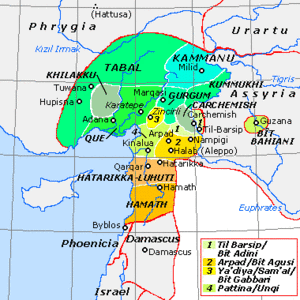Arpad (Syria)
Arpad later became a major vassal city of the Kingdom of Urartu. In 743 BC, during the Urartu-Assyria War, the Neo-Assyrian king Tiglath-Pileser III laid siege to Arpad following the defeat of the Urartuan army of Sarduri II at Samsat. But the city of Arpad did not surrender easily. It took Tiglath-Pileser three years of siege to conquer Arpad, whereupon he massacred its inhabitants and destroyed the city. Afterward Arpad served as a provincial capital. Tell Rifaat, which is probably the remains of Arpad, has walls still preserved to a height of eight meters.
Biblical references
The city is mentioned several times in the Hebrew Bible:
- 2 Kings 18:34; 19:13
- Isaiah 10:9; 36:19; 37:13
- Jeremiah 49:23, within the oracle against Damascus, one of the poetic "oracles against foreign nations" found in the later chapters of the Book of Jeremiah.
The Assyrian vizier, Rabshakeh, lists the god(s) of Arpad among those who he alleges have been unable to save their cities from Assyrian assault.
Etymology
The word Arpad in Hebrew means 'the light of redemption', or 'I shall be spread out (or: supported)'
Archaeology
Tel Rifaat is an oval 250 by 233 meters. Within this, the main citadel is 142 by 142 meters with a maximum height of 30 meters. The defensive wall surrounding the site is about two miles long.
The site has been worked by a team from the Institute of Archaeology or the University of London. After a preliminary examination in 1956, Tell Rifa'at was excavated for two seasons in 1961 and 1964. The team was led by Veronica Seton-Williams.
In 1977, an archaeological survey was conducted of the area around Tell Rifa'at, also by the Institute of Archaeology.
See also
Notes
- ^ "BDB, אַרְפַּד 1". www.sefaria.org.
- ^ Lipinsky, Edward (2000). The Aramaeans: Their Ancient History, Culture, Religion. Peeters Publishers. p. 195. ISBN 9789042908598.
- ^ Lipinsky, 2000, p. 99.
- ^ Healy, Mark (1992). The Ancient Assyrians. Osprey. p. 25. ISBN 9781855321632.
- ^ Kipfer, Barbara Ann (2000). Encyclopedic Dictionary of Archaeology. Springer Science & Business Media. p. 626. ISBN 9780306461583.
- ^ Lipinsky, 2000, p. 529.
- ^ Coogan, Michael David; Brettler, Marc Zvi; Newsom, Carol Ann; Perkins, Pheme (2007). The New Oxford Annotated Bible with the Apocryphal/Deuterocanonical Books: New Revised Standard Version, Issue 48. Oxford University Press. ISBN 9780195288810.
- ^ 2 Kings 18:34
- ^ "Arpad Definition and Meaning - Bible Dictionary". Bible Study Tools.
- ^ "NETBible: Arpad". classic.net.bible.org.
- ^ M. V. Seton Williams, Preliminary Report on the Excavations at Tell Rifa'at, Iraq, vol. 23, no. 1, pp. 68-87, 1961
- ^ M. V. Seton Williams, The Excavations at Tell Rifa'at: 1964 Preliminary Report on, Iraq, vol. 29, no. 1, pp. 16-33, 1967
- ^ John Matthers, Tell Rifa'at 1977: Preliminary Report of an Archaeological Survey, Iraq, vol. 40, no. 2, pp. 119-162, 1978
References
- Clayton, Peter A. "The Coins from Tell Rifa'at." Iraq 29, no. 2 (1967): 143-54. Accessed October 18, 2020. doi:10.2307/4199831.
- Millard, Alan R. "Adad-Nirari III, Aram, and Arpad" Palestine Exploration Quarterly, vol. 105 Issue 2 (1973): 161–164. Accessed October 18, 2020. doi:10.1179/peq.1973.105.2.161
